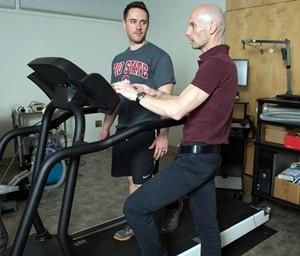14 April 2015. Researchers at Ohio State University designed an automated treadmill that adjusts to changes in running speed by users, thus making the experience more like running outdoors. Steven Devor, professor of kinesiology, with former graduate student Cory Scheadler (now on the faculty at Northern Kentucky University), describe tests of a prototype model of the treadmill in an article published last week in the journal Medicine & Science in Sports & Exercise (paid subscription required).
Ohio State reports filing a patent application for the system, with the objective of its licensing and commercialization for eventual use in health clubs.
Devor says the objective of the system is to make the experience of using a treadmill more realistic and pleasant. “So many people call it the ‘dreadmill,’ notes Devor in a university statement. “It is boring and monotonous. An automated treadmill makes the experience much more natural and you can just run without thinking of what pace you want to set.”
The key to device is an inexpensive, off-the-shelf sonar range finder, positioned behind the runner and aimed between the shoulder blades. Sonar beams measure the distance from the range finder to the runner. A built-in microcontroller and processor read the measurements and adjust the speed of the treadmill’s belt.
When the runner is in the middle of the belt’s length, measured from front to back, the treadmill keeps the speed constant. But if the distance of the runner from the sonar device increases — moves closer to the front of the belt — the treadmill increases the speed of the belt accordingly. Likewise, if the device detects the runner moving toward the back of the belt, the belt speed slows until the runner reaches the mid-point.
The journal article reports on a test with 13 experienced endurance runners who ran three sets on the automated treadmill, and later on the same treadmill, but without the sonar and computerized controller. Devor and Sheadler measured peak work rates and maximum oxygen volume, and report that the automated treadmill allowed for more accurate measurements of maximum oxygen volume than the non-automated device.
More accuracy in measuring maximum oxygen volume, say the researchers, helps determine heart rate target zones that guide training regimens.
Read more:
- Device Shown to Reduce Stroke in Heart Valve Replacements
- Heart-on-Chip Device Built to Screen Drugs
- Patent Issued for Mobile Pulse Oximetry Technology
- Mobile Heart Monitor Algorithm Approved in Europe
- Flexible Pulse Oximeter Designed for Wearable Devices
* * *


 RSS - Posts
RSS - Posts
You must be logged in to post a comment.